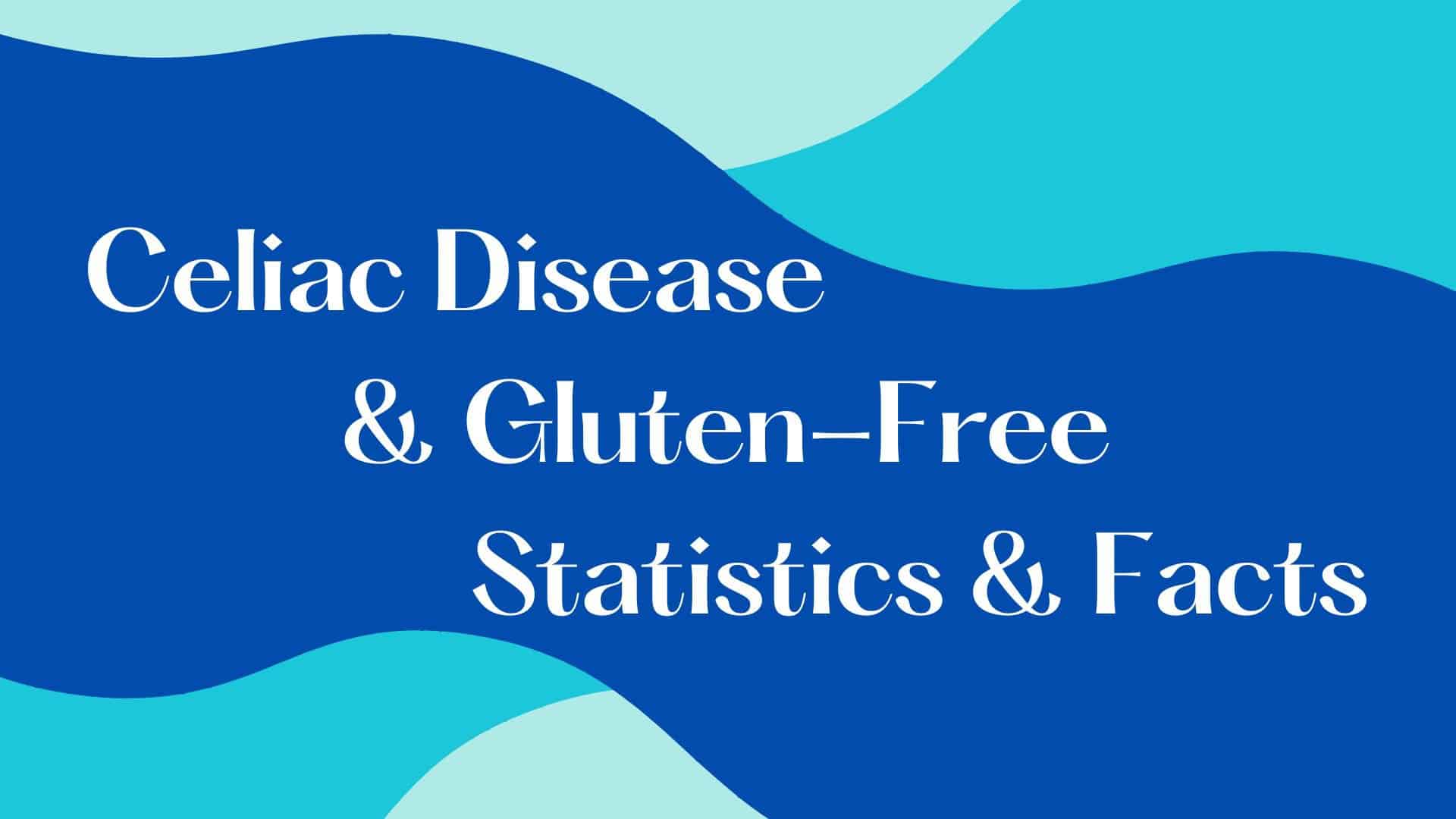75 Celiac Disease & Gluten-Free Statistics & Facts (2024)
Celiac disease is an autoimmune condition where the patient reacts to gluten-containing grains (wheat, barley, and rye) by attacking the lining of the small intestine, leading to malnutrition and related medical complications. The only way to stop this autoimmune response and treat celiac disease is the gluten-free diet.
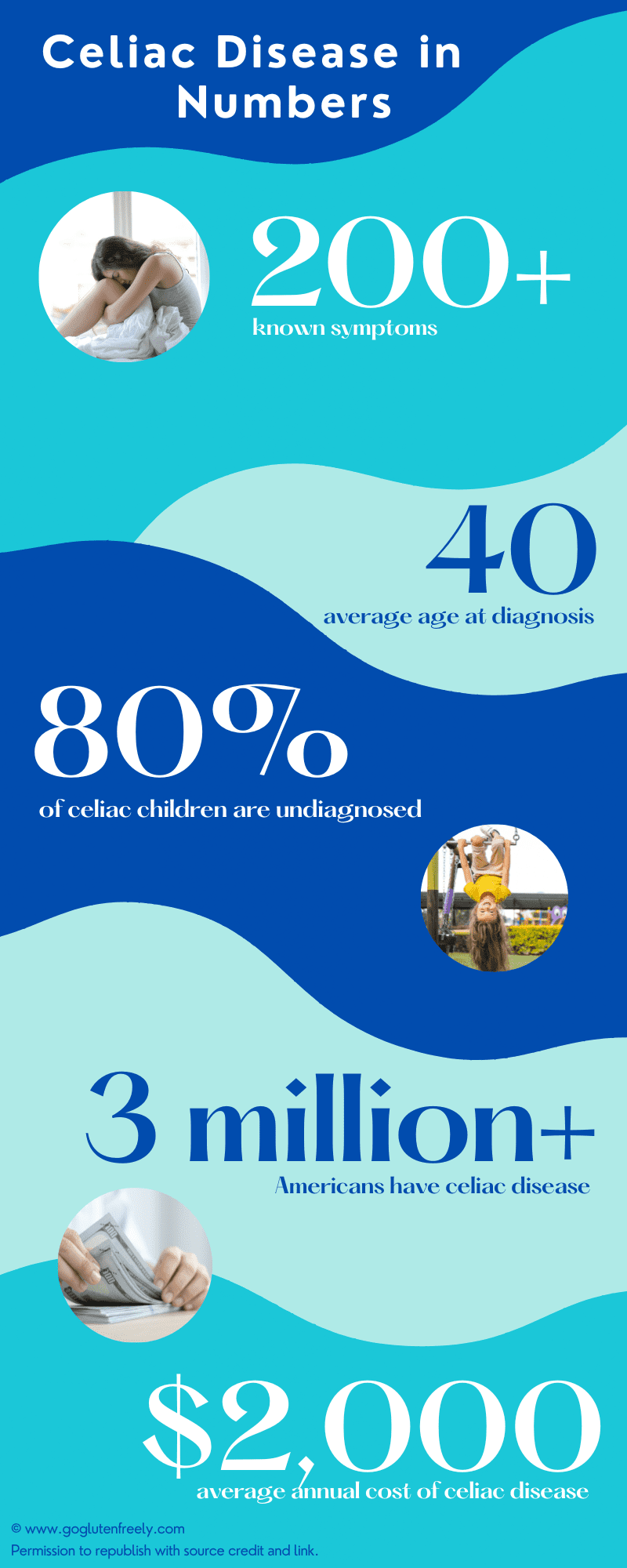
Here are 10 of the most compelling figures found in the 75 statistics, facts, and trends that follow:
- 1:100 Americans have celiac disease
- 4 years is the average time to be correctly diagnosed with celiac disease
- 83% (estimated) of Americans with celiac disease are undiagnosed or misdiagnosed
- 200+ known symptoms of celiac disease
- 7.5% rate of increase in celiac disease over the past several decades
- 6% (approximately) of the U.S. population is gluten intolerant
- $2,000 (approximate) average annual burden of celiac disease
- 23% of U.S. consumers shop for gluten-free products
- 80% of food products contain gluten
- $6.7B is the global gluten-free food market size estimated value in 2022
Some of the data is sobering. Celiac disease is much more common than previously thought. It is increasing and remains largely undiagnosed. Individuals with celiac disease face physical/mental health, social, and financial burdens.
Optimistically, awareness of celiac disease, research, and the gluten-free product market are all growing.
Following are 75 important statistics regarding celiac disease and the gluten-free diet.
Celiac Disease Basic Statistics and Facts
- The only treatment is lifelong adherence to a strict gluten-free diet. (Celiac Disease Foundation)
- Four years is the average time to be correctly diagnosed with celiac disease. (Celiac Disease Foundation)
- The most common age at diagnosis in the US is about 40 years. (Ludvigsson JF and Rubio-Tapia)
- 30-40% of the general population carries the two genes associated with celiac disease. (NIH)
- Only 3% of individuals with celiac-associated genes develop celiac disease. (NIH)
- Only 50% of Americans report knowing anything about celiac disease and/or gluten sensitivity. (Beyond Celiac)
Celiac Disease Symptoms: Statistics and Facts
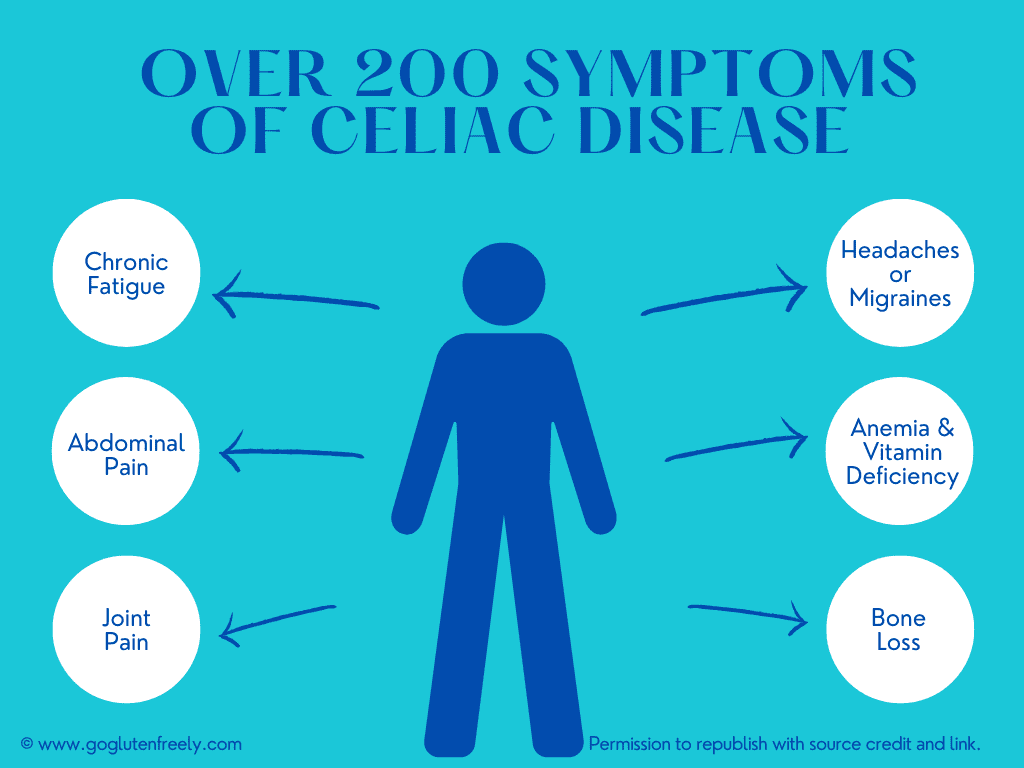
- There are more than 200 known symptoms of celiac disease. (Celiac Disease Foundation)
- There is an 8:1 ratio of non-intestinal vs. intestinal symptoms in wheat-related disorders, including celiac disease… for every adverse reaction presenting with GI symptoms, there are 8 presenting without GI symptoms. (Fronteirs in Pediatrics)
- Only 35% of newly diagnosed patients had chronic diarrhea. (University of Chicago)
- Common gastrointestinal symptoms of celiac disease include diarrhea, weight loss, bloating and gas, abdominal pain, nausea and vomiting, and constipation. (Celiac Disease Foundation)
- Common extra-intestinal symptoms of celiac disease include iron deficiency anemia, abnormal liver enzymes, arthritis, alopecia, brain fog, fatigue, headache, psychiatric disorders, rashes, seizures, neuropathy, short stature, delayed puberty, osteoporosis, and infertility. (Celiac Disease Foundation)
- 60% of children and 41% of adults diagnosed during a landmark study were asymptomatic. (University of Chicago)
- An estimated 83% of Americans who have celiac disease are undiagnosed or misdiagnosed. (Beyond Celiac)
Prevalence of Celiac Disease in the United States: Statistics
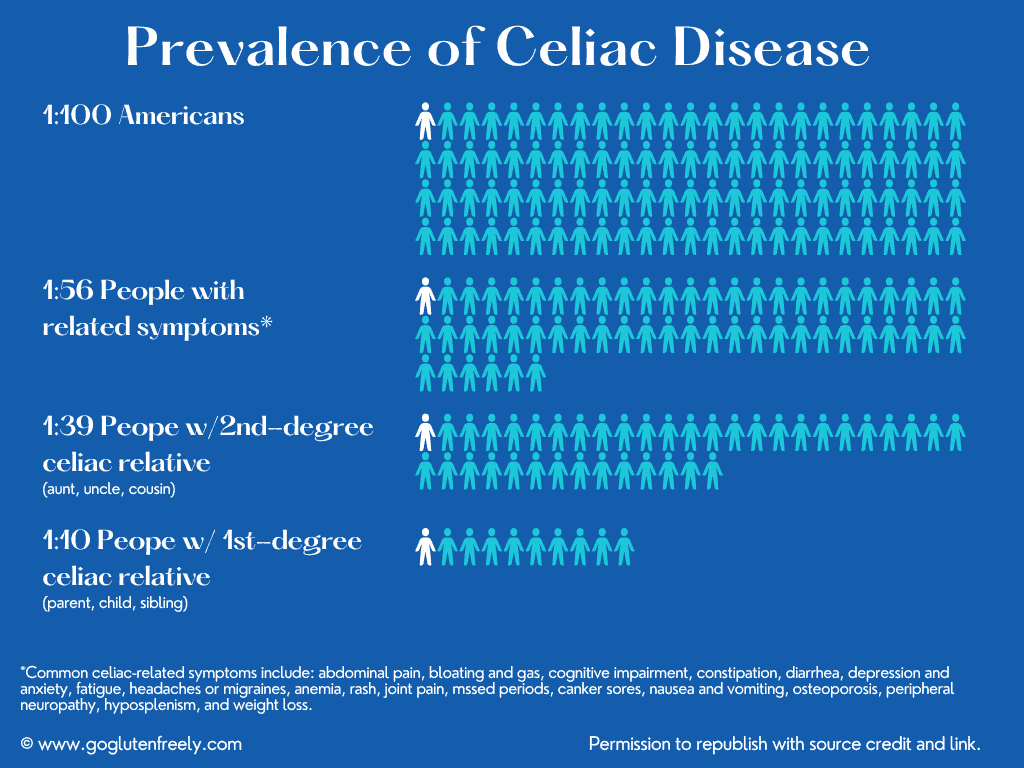
- 3 million+ Americans have celiac disease. (Celiac Disease Foundation)
- 0.9% of US college students have been diagnosed with celiac disease. (Statista)
- The prevalence of celiac disease has increased 4 or 5-fold since 1950. (Celiac Disease Foundation)
- Prevalence of Celiac disease in the general U.S. population: approximately 1:100 (Columbia University, Celiac Disease Center)
- Prevalence of Celiac disease in people with celiac-related symptoms: 1 in 56 (University of Chicago)
- Prevalence of Celiac disease in people with second-degree family members (aunt, uncle, cousin) who are celiac: 1 in 39 (University of Chicago)
- Prevalence of Celiac disease in people with first-degree relatives (parent, child, sibling) who are celiac: 1 in 10 (Columbia University, Celiac Disease Center)
- Shockingly, a retrospective study of Mayo Clinic data found that 44% of screened first-degree relatives had celiac disease. Of those patients, 94% had symptoms that were not classic or had no symptoms at all. (Mayo Clinic)
Prevalence & Growth of Celiac Disease Globally: Statistics and Trends
- Celiac disease affects an average of 1–1.5% of Western populations, its incidence is surging worldwide even in far-east and underdeveloped countries. (Fronteirs in Pediatrics)
- The current worldwide prevalence of celiac disease is 1.4% based on blood tests and 0.7% based on biopsy results. (Celiac Disease Foundation)
- In Finland, the prevalence of celiac disease has been estimated at 1.99% of the population. (Beyond Celiac)
- Celiac disease has a seroprevalence rate of 1.4%, with prevalence varying by continent from 1.3% (South America, 11 studies) to 1.8% (Asia, 20 studies). (American Gastroenterological Association)
- A Scottish pediatric study demonstrated a 6.4-fold increase in the incidence of celiac disease over the 20 years between 1990-2009. (Dr Schaer)
- Incidence rates of celiac disease are increasing, with an average of 7.5% increase per year over the past several decades. (Celiac Disease Foundation)
Related Diseases and Medical Conditions: Statistics
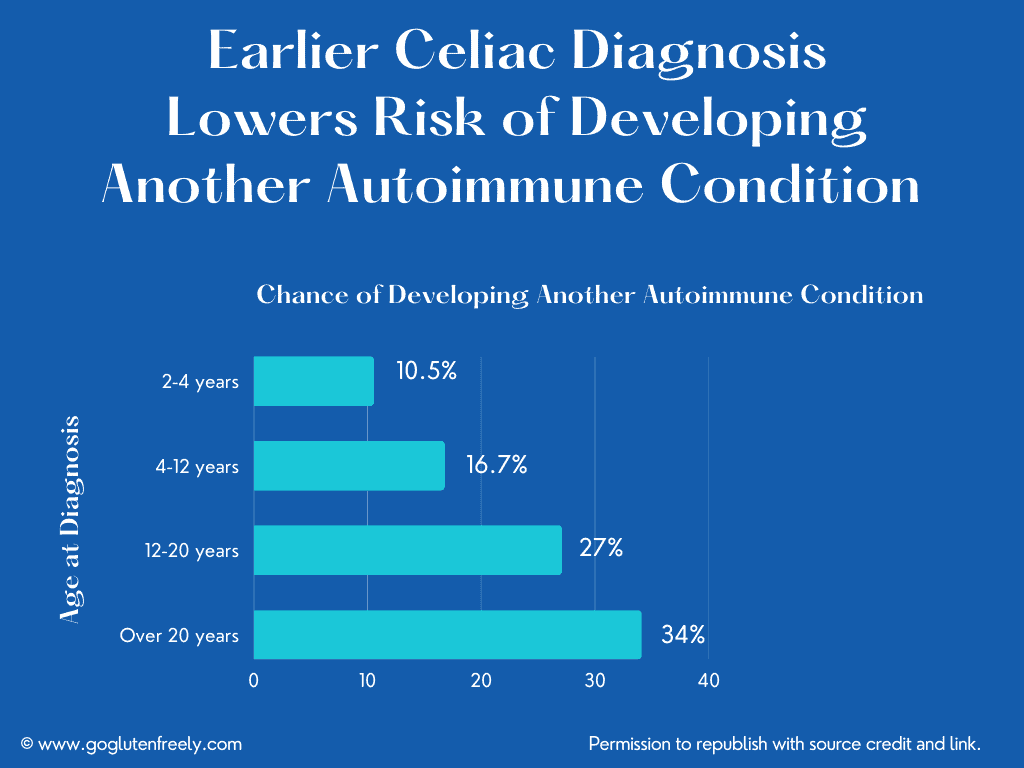
- Of women struggling with fertility, 6% may be due to celiac disease. (University of Chicago)
- 12% (42,000) of people with Down Syndrome also have celiac disease. (University of Chicago)
- 6% (180,000) of those diagnosed with Type 1 diabetes also have celiac disease. (University of Chicago)
- Approximately 0.4% of the world’s population is allergic to wheat. (Science Direct)
- About 6% of the U.S. population is gluten intolerant. (Cleveland Clinic)
- Dermatitis herpetiformis (an autoimmune skin rash) affects 10-15% of people with celiac disease. (Celiac Disease Foundation)
- Early diagnosis lowers the chance of developing another autoimmune disease. A patient’s chance of developing another autoimmune disorder is 10.5% with an age of diagnosis of 2-4 years. The risk increases to 16.7% at 4-12 years, 27% at 12-20 years, and 34% with an age at diagnosis of over 20 years. (Celiac Disease Foundation)
Celiac Disease in Women: Statistics and Facts
- As commonly found in other autoimmune disorders, celiac disease is more prevalent in women than in men, with up to twice as many women affected. (Dr Schaer)
- Current research indicates that 60% to 70% of those diagnosed with celiac disease are women. (Beyond Celiac)
- For many women, unexplained infertility is the only sign of undiagnosed celiac disease. (Beyond Celiac)
Celiac Disease in Children: Statistics and Facts
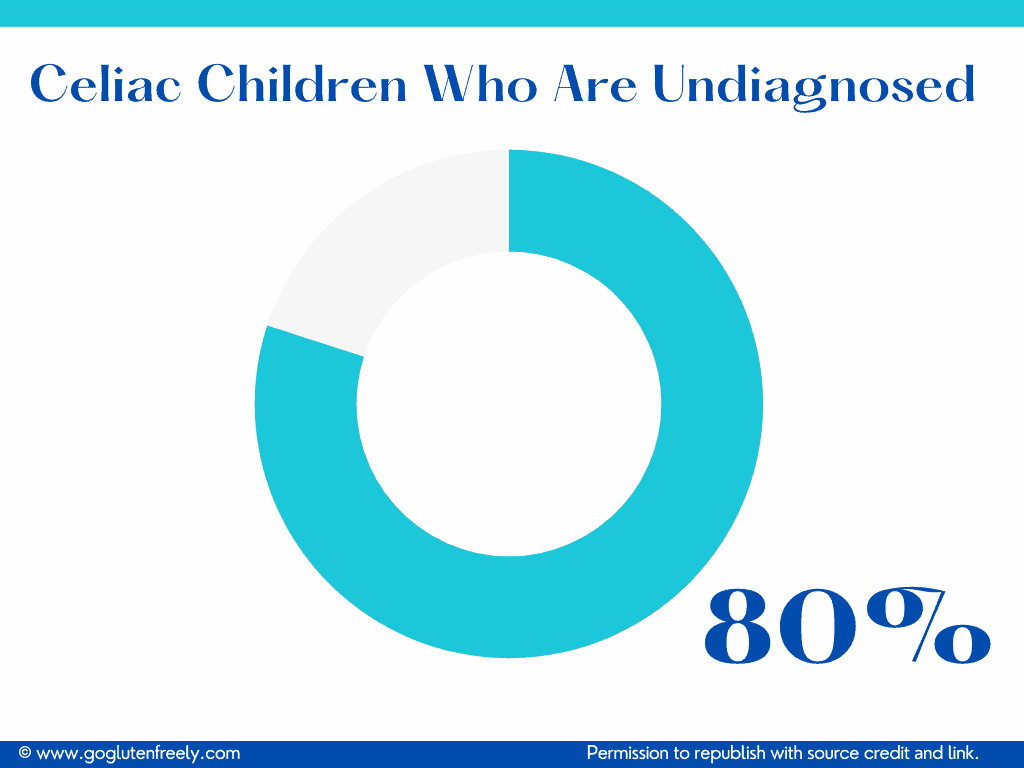
- Common celiac disease symptoms in kids include decreased appetite, Failure to thrive/delayed growth or puberty (short stature), swollen belly, anemia, bloating and gas, chronic diarrhea or constipation, damaged or discolored tooth enamel, fatigue, itchy skin rash (known as dermatitis herpetiformis), poor weight gain, and vomiting. (Beyond Celiac)
- As many as 10% of children with no cause for delayed growth may have celiac disease. (Beyond Celiac)
- Diagnosis of celiac disease is missed in over 80% of children. (NIH)
- Rates of celiac disease are from 3-8% of children with otherwise unexplained short stature. (Very Well Health)
Burden of Celiac Disease: Statistics and Facts
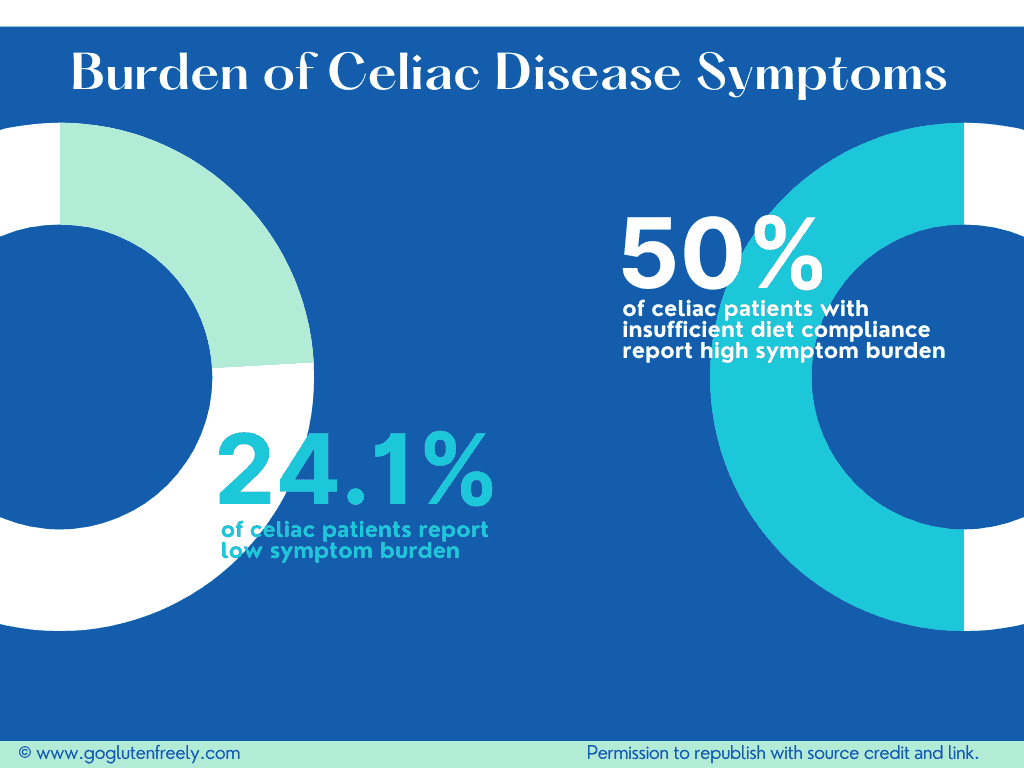
- Only 24.1% of celiac patients report a low disease symptom burden. (Celiac Disease Foundation)
- Among celiac disease patients who are not sufficiently adhering to a gluten-free diet according to the Celiac Dietary Compliance Test, more than 50% report high symptom burden, poor quality of life, and missed, on average, 5 weeks of work or school a year due to illness associated with celiac disease. (Celiac Disease Foundation)
- iCureCeliac® patient registry participants report missing 23 days of work/school annually due to celiac-related illness, with 74% having been accidentally exposed to gluten within the past 30 days. (Celiac Disease Foundation)
- In a survey of patients in four countries (USA, United Kingdom, Germany, and Spain), the most commonly reported challenges in maintaining a GFD were the cost of gluten-free products, the need to constantly plan meals and eating arrangements ahead of time, social restrictions, the risk of gluten cross-contamination, and the availability of gluten-free options. (Celiac Disease Foundation)
- Over a four-year period, people with undiagnosed celiac disease cost an average of $3,964 more than healthy individuals. (Alimentary Pharmacology & Therapeutics)
- As a whole, patients with celiac disease report “lower qualities of life” (University of Chicago)
- Celiac patients have higher lifetime rates of depression (31%), anxiety (21%), and eating disorders (7%). (University of Chicago)
- The average annual burden of nearly $2,000 for individuals with celiac disease compared to those without. (Celiac Disease Foundation)
- 96% of respondents in a Coeliac UK survey found it difficult to find gluten-free options on the go. (Coeliac Disease UK)
Mortality Risk Associated with Celiac Disease: Statistics
- 6x increased risk of death from non-Hodgkin’s lymphoma (Celiac Disease Foundation)
- 3.1x increased risk of death from liver disease (Celiac Disease Foundation)
- 2.6x increased risk of death by pneumonia (Celiac Disease Foundation)
- 4x increased risk of small bowel cancer (Celiac Disease Foundation)
Gluten-Intolerance and Non-Celiac Gluten-Sensitivity: Statistics and Facts
- An estimated 18 million Americans are sensitive to gluten. (RN.com)
- Non-celiac gluten sensitivity (NCGS) is a condition that presents with celiac-like symptoms. Blood tests (serology) and/or biopsy results for celiac disease are negative. Removing gluten from the diet improves symptoms. (Beth Israel Deaconess Medical Center)
- Non-celiac gluten sensitivity, a less-known clinical entity has been estimated to have a prevalence of up to 6% in the United States. (World Journal of Gastroenterology)
Gluten-Free Diet: Statistics and Facts
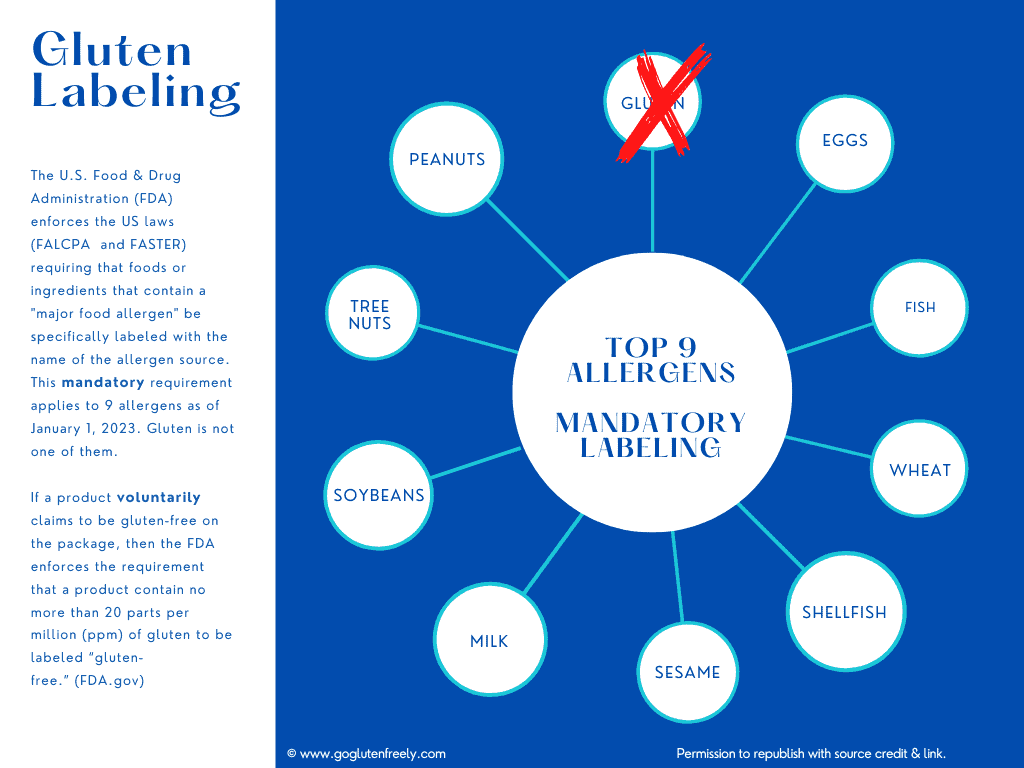
- Millennials are the generation most likely to follow a gluten-free diet in the US. (Statista)
- Gluten-free substitutes contain more fat and sugar, and fewer nutrients. (Celiac Disease Foundation)
- 23% of consumers are shopping for gluten-free products in the US. (Gluten Intolerance Group)
- Gluten is virtually impossible to avoid, as it is in 80% of food products. (Celiac Disease Foundation)
- 2 out of 3 gluten-free shoppers look for the Gluten-Free Certification Organization (GFCO) mark over a gluten-free claim or reading the ingredient label. (Gluten Intolerance Group)
- Only 5% of gluten-free breads were fortified with all four mandatory fortification nutrients (calcium, iron, niacin, and thiamin). (Fronteirs in Pediatrics)
- The U.S. Food & Drug Administration (FDA) enforces the US law requiring that foods or ingredients that contain a “major food allergen” be specifically labeled with the name of the allergen source (9 allergens as of January 1, 2023). Gluten is not one of them. (FDA)
- If a product voluntarily claims to be gluten-free on the package, then the FDA enforces the law that a product must contain no more than 20 parts per million (ppm) of gluten to carry a “gluten-free” claim. (Celiac Disease Foundation)
Gluten-Free Food Market: Statistics, Trends, and Facts
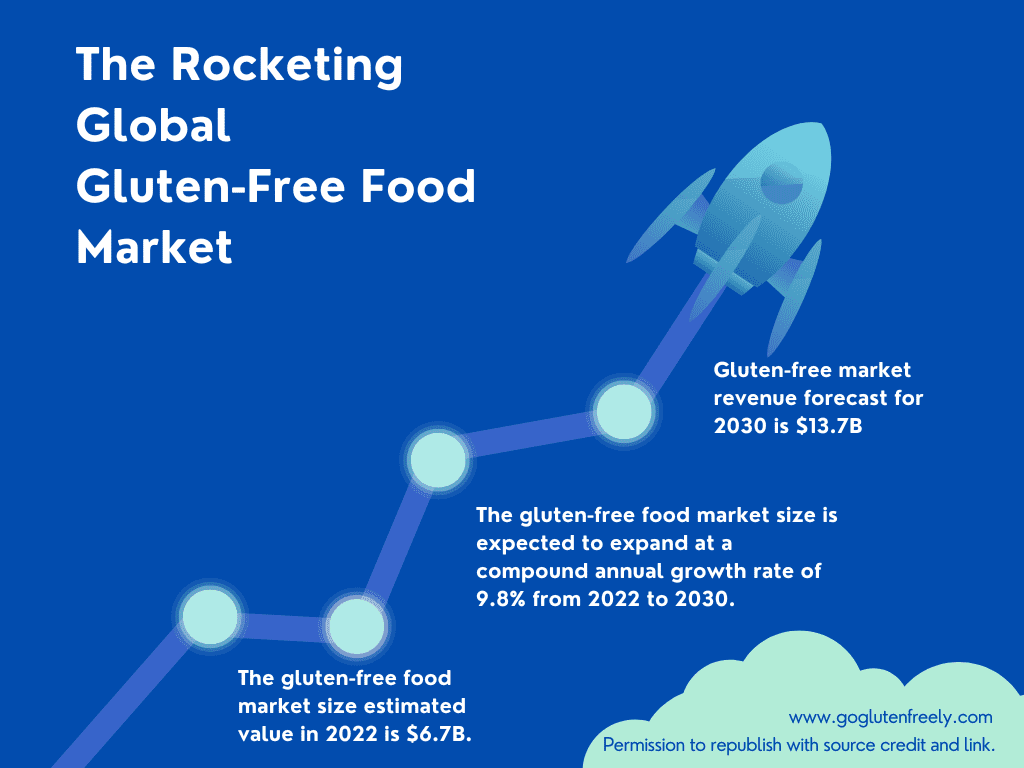
- The global gluten-free food market size estimated value in 2022 is $6.7B. (Statista)
- The global gluten-free market revenue forecast for 2030 is $13.7B (Grand View Research)
- The global gluten-free food market size is expected to expand at a CAGR* of 9.8% from 2022 to 2030. (Grand View Research)
- The gluten-free bakery products segment accounts for the largest revenue share of nearly 57% of global sales of gluten-free foods in 2022. (Statista)
- The global gluten-free bakery products segment is projected to register the fastest CAGR* of 10.9% from 2022 to 2030. ( Grand View Research)
- The online segment is anticipated to witness the fastest CAGR* of any channel, 11.5% from 2022 to 2030. (Grand View Research)
- North America dominated the market and accounted for the largest revenue share of 36.9% in 2021 (Grand View Research)
- In Asia Pacific, the market is expected to register the highest CAGR* of 12.1% from 2022 to 2030. (Grand View Research)
- Some of the prominent players in the gluten-free products market include: Conagra Brands, Inc., The Hain Celestial Group Inc., General Mills Inc., Kellogg Co., The Kraft Heinz Company, Hero AG, Barilla G. e R. Fratelli S.p.A, Seitz glutenfrei, Freedom Foods Group Limited, and Ecotone (Grand View Research)
- General Mills Inc. is making nearly 90% of all its Cheerios breakfast cereals gluten-free. (Grand View Research)
*CAGR = Compound annual growth rate
For more information about celiac disease, visit our Frequently Asked Questions.

